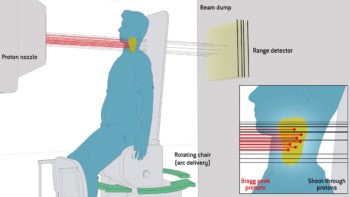
The effectiveness of proton therapy using pencil-beam scanning technology can be offset by the interplay effect, in which relative motion between the tumour and the scanning proton beam causes deviation of the delivered dose distribution from the original treatment plan.
The interplay effect has been widely investigated in adult patients but minimally in children. Now, researchers at St. Jude Children’s Research Hospital have investigated the effect of interplay between respiration-induced tumour motion and spot-scanning proton beams on internal target volume (ITV) coverage in paediatric patients. They performed simulations for a sample of patients, aged from two to 19 years, who had previously received radiotherapy for abdominal tumours (Int. J. Particle Ther. 10.14338/IJPT-17-00030.1).
Led by Chia-ho Hua, the team of medical physicists and radiation oncologists selected 10 representative patients who were treated with photon-based radiotherapy for neuroblastoma, Hodgkin lymphoma, osteosarcoma and Wilms tumour. The group had a maximum tumour motion ranging from 1.2 to 13.5 mm, respiration rates of 18 to 37 breaths per minute, and ITV of 11.2 to 295.8 cm3.
The patients underwent free-breathing 4D MRI and 3D CT as part of the treatment planning process. The authors generated a virtual 4D CT data set by spatially registering the 4D MRI data to the 3D CT data, and used it to plan a hypothetical proton treatment and calculate the corresponding 4D dose distribution. This approach provides a radiation-free method for detection of soft-tissue motion and enables image orientation along the primary direction of respiratory motion.
The researchers developed two-field proton treatment plans using single-field uniform dose (SFUD) optimization that expanded the ITV by 5 mm to generate the planning target volume (PTV). The plans achieved uniform dose to the PTV in which the hot spots did not exceed 110% of the prescribed dose. They note that in the original static plans, hot spots were kept below 110% and cold spots above 98.5% of the prescribed dose.
The authors calculated 4D dose distributions, taking into account the interplay effect, for comparison with the nominal dose distribution. They simulated the motion interplay effect by assigning each spot in the static plan delivery sequence to one of 10 respiratory-phase CTs, and by using the actual patient breathing trace and the specifications of a synchrotron-based proton system.
After summing individual respiratory phases to produce accumulated dose distributions, Hua and colleagues compared the resulting dose–volume histogram with that from the static plan. To evaluate the interplay effect, they calculated dose to 98% and 2% of the ITV and the percentage of the ITV receiving at least 95% and 99% of the prescribed dose.
They reported that motion interplay did not significantly increase the hot spot dose or decrease the cold spot dose by more than 3% for a given treatment fraction. Motion interplay caused minimal changes in the delivered dose in four patients who had a maximal vertical target motion of less than approximately 5 mm. These patients, aged two, four, six and nine, had neuroblastoma with tumours located in the retroperitoneal space.
While the interplay effect was almost negligible for young children with minimal superior–inferior target motion, teenagers with more extensive target motion had different interplay effects. An 11-year old patient who had the greatest amount of tumour motion exhibited the worst coverage loss. This was comparable to a 15-year old patient with metastasis from osteosarcoma, who experienced significant interplay effects manifesting in tumour coverage and dose inhomogeneity.
The researchers note that patients with tumour motion less than 10 mm would have had better tumour coverage with increased fractionation, but fractionation alone did not appear to further mitigate the interplay effect beyond six fractions.
Patient selection
The authors recommend that consensus guidelines on implementing pencil-beam scanning proton therapy for adult lung cancer and lymphoma patients are used as starting points for treating paediatric patients with proton therapy. They note that optimal mitigation strategies need to consider how well a paediatric patient will cooperate, the effects of sedation on respiration, and issues relating to tumour size and location.
“We hypothesize that children and adolescents with tumour motion of less than 10 mm can be safely treated with spot-scanning beams, as long as the beam angles are properly chosen and the tumours are not particularly deeply situated,” they wrote. “With a greater tumour motion than 10 mm, techniques such as respiratory gating and repainting should be considered.”
“St. Jude is currently using proton beams to treat abdominal tumours,” Hua tells Physics World. “However, we proceed with caution and select only appropriate candidates to treat with scanning proton beams. Smaller motion extent and focal treatment are two of the major criteria.”
For children and adolescents with larger tumour motion in the abdomen or thorax, based on 4D CT and 4D MRI evaluation, the clinical physics team is implementing advanced motion management techniques to safely and effectively deliver proton beams.
“Research like our interplay effect study allows us to predict which patients with moving tumours may be better candidates for pencil-beam scanning proton therapy and which patients need more aggressive motion management to prevent underdosing tumours and overdosing adjacent critical organs,” says Hua. “Such clinical research has been rare for paediatric cancer patients but is critical in protecting this most vulnerable population.”



